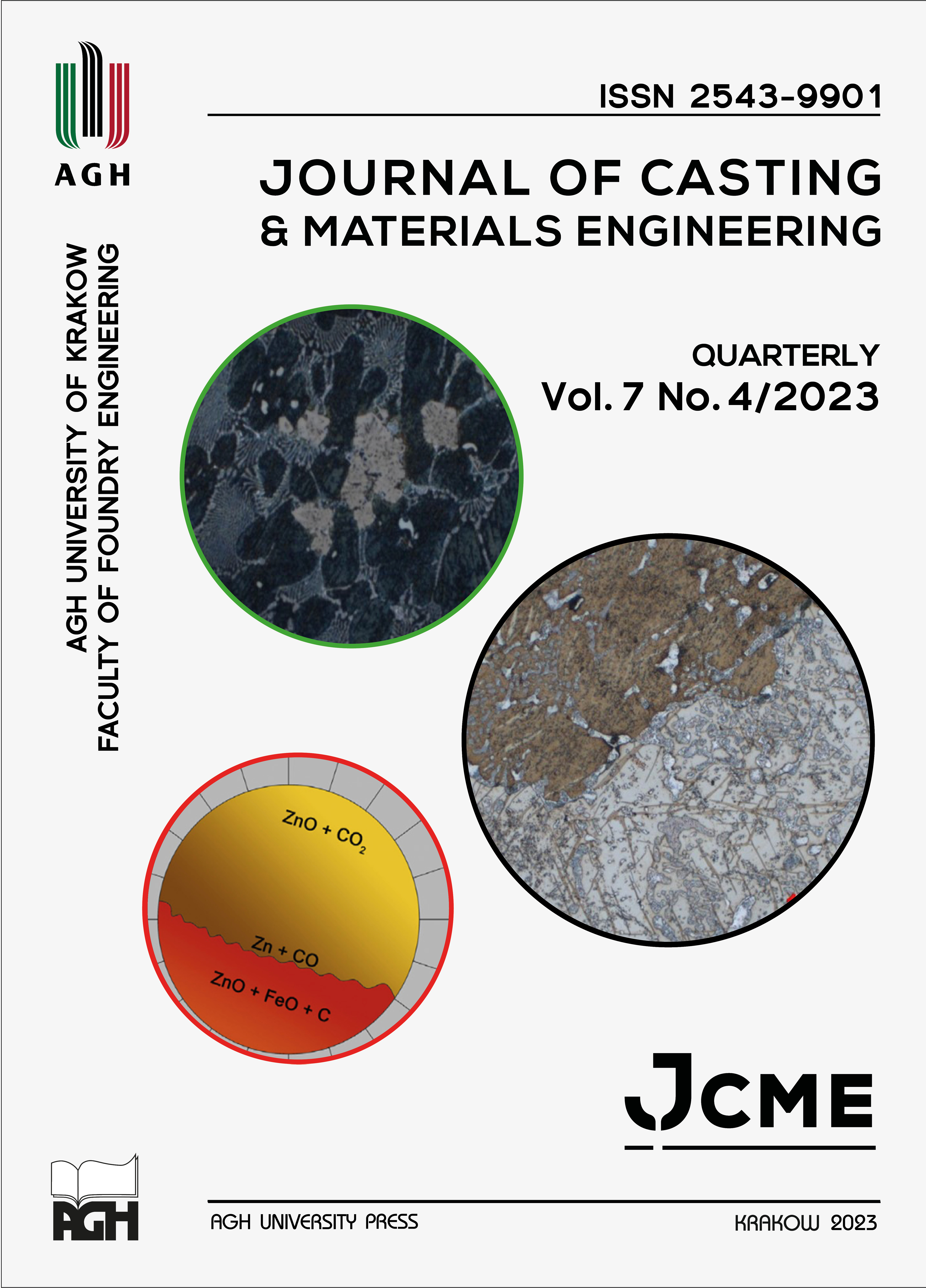Effect of Titanium Alloying of Zn-Al-Cu Alloys for High Pressure Die Casting in Production Conditions
DOI:
https://doi.org/10.7494/jcme.2023.7.4.56Abstract
The paper presents the possibility of the industrial production of Zn4Al3Cu alloy with the addition of 0.41% Ti. Tests are described on the manner of introducing the ZnTi2 master alloy to the alloy, so that the chemical composition of the desirable elements proportion is obtained. The chemical persistence of the Zn4Al3CuTi was determined as low in the conditions of the long heating of the alloy before casting. Tests on the microstructure and mechanical properties of the obtained alloys were also conducted. The strength of the die-cast Zn4Al3Cu alloy was 265 MPa and, when measured on samples taken from the high pressure die-cast, it reached 369 MPa. It was determined that the addition of titanium to the Zn4Al3Cu alloy causes significant refinement of the structure and contributes to the formation of intermetallic phases.
Downloads
References
Yan Shu-qing, Xie Jing-pei Wang Wen-yan & Li Ji-wen (2009). Microstructure and tensile property of Zn-Al alloy reinforced with titanium produced by electrolysis. Advanced Materials Research, 79‒82, 1415‒1418. Doi: https://doi.org/10.4028/www.scientific.net/AMR.79-82.1415.
Wang Jianhua, Wang Xiande, Tu Hao & Su Xuping (2011). Effects of titanium on microstructure and mechanical properties of ZnAl4Y alloy. China Foundry, 4, 397–400.
Engineering in Zinc, Today’s Answer (2019). Retrieved from https://www.zinc.org/engineering-in-zinc-todays-answer/ [accessed: 14.12.2023].
Jemielewski J. (1970). Odlewnictwo metali nieżelaznych. Wydawnictwa Naukowo-Techniczne, Warszawa.
Zyska A., Konopka Z., Łągiewka M., Nadolski M. & Chojnacki A. (2009). High-aluminium zinc alloy (ZnAl27Cu2) modified with titanium and boron. Archives of Foundry Engineering, 9(4), 237‒240.
Krajewski W. (1996). Phases of heterogeneous nucleation in the ZnAl25 alloy modified by ZnTi and AlTi master alloys. Materials Research and Advanced Techniques, 87(8), 645651.
Leis-Speaker W. & Kallien L. (2013). Ageing and creep behaviour of Zinc-Diecasting-Alloys. International Zinc Diecasting Conference “Tradition & Innovation”, Prague, Czech Republic, 13‒14 June 2013. Retrieved from https://www.yumpu.com/en/document/view/40575985/ageing-and-creep-behaviour-of-zinc-diecasting-alloys-international- [accessed: 14.12.2023].
Von W. Heine & U. Zwicker (1962). Untersuchungen an Legierungen des Systems Zink-Titan. International Journal of Materials Research, Zeitschrift für Metallkunde, 53(6), 380‒385. Doi: https://doi.org/10.1515/ijmr-1962-530607.
Sailin Fan, Changjun Wu, Ya Liu, Hao Tu, Xuping Su & Jianhua Wang (2017). 600 and 450°C isothermal sections of the Zn-Ce-Ti system. Journal of Alloys and Compounds, 709, 842‒849. Doi: https://doi.org/10.1016/j.jallcom.2017.03.215.
Piwowarski G., Buraś J. & Krajewski W.K. (2013). Wpływ zabiegu modyfikowania zaprawą ZnTi3,2 na mikrostrukturę stopu ZnAl10. Archives of Foundry Engineering, 13(spec. iss. 3), 129‒132.
Kallien L.H. & Leis W. (2011). Ageing of Zink Alloys. International Foundry Research, 64(1), 1‒23.
Sui Yang, Xuping Su, Jianhua Wang, Fucheng Yin, Zhi Li, Hao Tu & Haoping Peng (2010). The Zn-rich corner of the Zn-Al-Ti system at 723 K. Journal of Alloys and Compounds, 499(2), 194‒199. Doi: https://doi.org/10.1016/j.jallcom.2010.03.148.
Krupińska B., Rdzawski Z. & Labisz K. (2011 ). Crystallisation kinetics of the Zn-Al alloys modified with lanthanum and cerium. Journal of Achievements of Materials and Manufacturing Engineering, 46(2), 154‒160.
Pastirčák R., Brůna M., Matejka M. & Bolibruchová D. (2023). Effect of input parameters on the structure and properties of castings obtained via crystallization under pressure. Metals, 13(8), 1424. Doi: https://doi.org/10.3390/met13081424.
Downloads
Published
Issue
Section
License
Copyright (c) 2023 Łukasz Pasierb, Jan Łakomski, Krzysztof Figurski

This work is licensed under a Creative Commons Attribution 4.0 International License.
How to Cite
Accepted 2023-12-14
Published 2023-12-15


